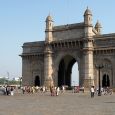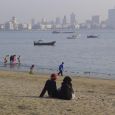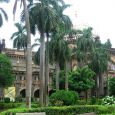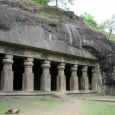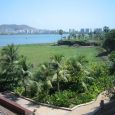Mumbai
Advertisement
Air
The Chhatrapati Shivaji International Airport (formerly Sahar International Airport) is the main aviation hub in the city and the busiest airport in India in terms of passenger traffic. In 2007, it catered to over 25 million passengers. An upgrade plan initiated in 2006, targeted at increasing the capacity of the airport to handle up to 40 million passengers annually by 2010, is expected to be completed on time
The proposed Navi Mumbai International Airport to be built in the Kopra-Panvel area has been sanctioned by the Indian Government and will help relieve the increasing traffic burden on the existing airport.
The Juhu Aerodrome was India's first airport, and now hosts a flying club and a heliport.
Rail
Mumbai is the headquarters of two of Indian Railways' zones: the Central Railway (CR) headquartered at Chhatrapati Shivaji Terminus (formerly Victoria Terminus), and the Western Railway (WR) headquartered at Churchgate. The backbone of the city's transport, the Mumbai Suburban Railway, consists of three separate rail networks: Central, Western, and Harbour Line, running the length of the city, in the north-south direction.Mumbai's suburban rail systems carried a total of 6.3 million passengers every day in 2007, which is more than half of the Indian Railways daily carrying capacity. Trains are overcrowded during peak hours, with nine-car trains of rated capacity 1,700 passengers, actually carrying around 4,500 passengers at peak hours.
Mumbai Metro is an underground and elevated rapid transit system currently under construction. The Mumbai Monorail, currently under construction, will eventually run from Jacob Circle to Wadala
Mumbai is well connected to most parts of India by the Indian Railways. Long-distance trains originate from Chhatrapati Shivaji Terminus, Dadar Station, Lokmanya Tilak Terminus, Mumbai Central Station, Bandra Terminus, Andheri and Borivali.
Road
Mumbai is served by National Highway 3, National Highway 4 and National Highway 8 of India's National Highways system. The Mumbai-Pune Expressway was the first expressway built in India,while the Mumbai-Vadodara Expressway,Western Freeway and Eastern Freeway is under construction. The Bandra-Worli Sea Link bridge, along with Mahim Causeway, links the island city to the western suburbs. The three major road arteries of the city are the Eastern Express Highway from Sion to Thane, the Sion Panvel Expressway from Sion to Panvel and the Western Express Highway from Bandra to Borivali.
Mumbai's bus services carried over 5.5 million passengers per day in 2008. Public buses run by BEST cover almost all parts of the metropolis, as well as parts of Navi Mumbai, Mira-Bhayandar and Thane. Buses are generally favored for commuting short to medium distances, while train fares are more economical for longer distance commutes. The BEST operates a total of 4,013 buses with CCTV Camera installed, ferrying 4.5 million passengers daily over 390 routes.Its fleet consists of single-decker, double-decker, vestibule, low-floor, disabled-friendly, air-conditioned and Euro III compliant Compressed Natural Gas powered buses. Maharashtra State Road Transport Corporation (MSRTC) buses provide intercity transport and connect Mumbai with other major cities of Maharashtra and India. Navi Mumbai Municipal Transport (NMMT) also operate its Volvo buses in Mumbai, from Navi Mumbai to Bandra, Dindoshi and Borivali. The Mumbai Darshan is a tourist bus service which explores numerous tourist attractions in Mumbai. Mumbai BRTS (Bus Rapid Transit System) lanes have been planned throughout Mumbai, with buses running on seven routes as of March 2009. Though 88% of the city's commuters travel by public transport, Mumbai still continues to struggle with traffic congestion.Mumbai's transport system has been categorized as one of the most congested in the world.
Due to further aggravation of congestion on roads due to hawkers and parked vehicles, MMRDA has initiated the Mumbai Skywalks project to provide quick and safe pedestrian dispersal from highly congested areas such as Mumbai Suburban Railway stations to heavily targeted destinations.
Sea
Mumbai is served by two major ports, Mumbai Port Trust and Jawaharlal Nehru Port Trust, which lies just across the creek in Navi Mumbai. Mumbai Port has one of the best natural harbours in the world, and has extensive wet and dry dock accommodation facilities. Jawaharlal Nehru Port, commissioned on 26 May 1989, is the busiest and most modern major port in India. It handles 55–60% of the country's total containerized cargo.
Mumbai is the headquarters of the Western Naval Command, and also an important base for the Indian Navy.
Ferries from Ferry Wharf in Mazagaon allow access to islands near the city.
Chowpatty Beach
Chowpatty Beach is a place that requires no introduction. No tour to Mumbai is complete without visiting this lively beach, which is not meant for sunbathing or swimming, but for eating. Situated at the northern end of Marine drive, Chowpatty Beach is popular amongst people of all age groups. Every evening, this beach gets stuffed with people, amidst food kiosks, ferry rides, balloon sellers, etc. Indeed, it's a place where you would love to come after a tiring day to please your taste buds, suck in some fresh air and gradually cooling your heels.
Moreover, it hosts various festivals of the Hindus throughout the year. Coconut Festival and Ganesh Chaturthi are the events that bring together people, from all stratus of the Commercial Capital of India. During the sunlight hours, Chowpatty Beach makes the resort of the people who doze under the shade of small trees. However, the evenings transform the whole beach into a venue for some carnival, where children enjoy in ferry rides and pony rides, while curb wayside astrologers make some swift money.
You can delight in the shows of professional masseurs, beebee-gun shooting galleries, contortionists, snake charmers and monkey-trainers. Take a quick bite of 'bhel-puri' that once eaten, you will not be able to resist. Relish the local delicacies such as Pav Bhaji, Pani Puri and Kulfi sold at local stalls dotting the beach. Chowpatty Beach acts as a hangout for masses in all seasons. Don't forget to explore this lively beach of Mumbai, where evenings are bustling and days are quite somber.
Bombay Natural History Museum
The Bombay Natural History Society was founded in 1883 for the purpose of exchanging notes and observations on natural history and exhibiting interesting specimens. Today it is the largest non-governmental organisation (NGO) in the subcontinent engaged in the conservation of nature and natural resources, education and research in natural history, with members in over 30 countries. The Society's guiding principle has always been that conservation must be based on scientific research-a tradition exemplified by its late president, Dr. Salim Ali.
Powai Lake
Powai Lake is situated in the Northern Suburb of Mumbai. It is an artificial lake, towards the west of the Indian Institute of Technology, the premier institute of Science and Technology. The lake, built by the British in 1890, adds to the charm of the Bombay city of India. It owes it name to Framaji Kavasji Powai Estate, belonging to a Parsi merchant. Just 25 km from Central Mumbai, Powai Lake is a perfect retreat away from the hustle and bustle of the city. Powai Lake once served as a source of drinking water for the Mumbai natives, but has now been declared unpalatable.
However, the serene and pleasant ambience of the place attracts a lot of tourists throughout the year. It also serves as a great picnic spot for the people to wander lazily around its bank and enjoy the bliss of solitude. The natural beauty of the place is simply enthralling and leaves you spell bound. Powai Lake is easily approachable from King's Circle, Sion and Kurla as well as from Santa Cruz and Andheri. A delightful car drive can be enjoyed when traveling by car. The lake is a stretch of water just by the side of a motorable road.
Gateway of India
The Gateway of India on the waterfront in Mumbai is a 26 metres high arch, just like India Gate in New Dehli and Arc de Triomphe in Paris. In earlier times visitors arrived by boat here. The arch was built in the period from 1911 to 1924. It is located close to Taj Mahal Palace and in the Apollo Bunder area in South Mumbai.
Elephanta Caves
Located about 10 kms from the Gateway of India or 9 nautical miles into the sea, are the famous Elephanta Caves, which are a great tourist attraction. It is about an hour?s ferry ride away. They are also known as Gharapuri and were named Elephanta caves by the Portuguese, after the statue of an elephant near the landing area of the island. The entire cave temple complex covers an area of about 60,000 square feet and it consists of a main chamber and two lateral ones, courtyards and several subsidiary shrines. There are regular excursions to these caves every day from the Gateway of India.
Information not available


